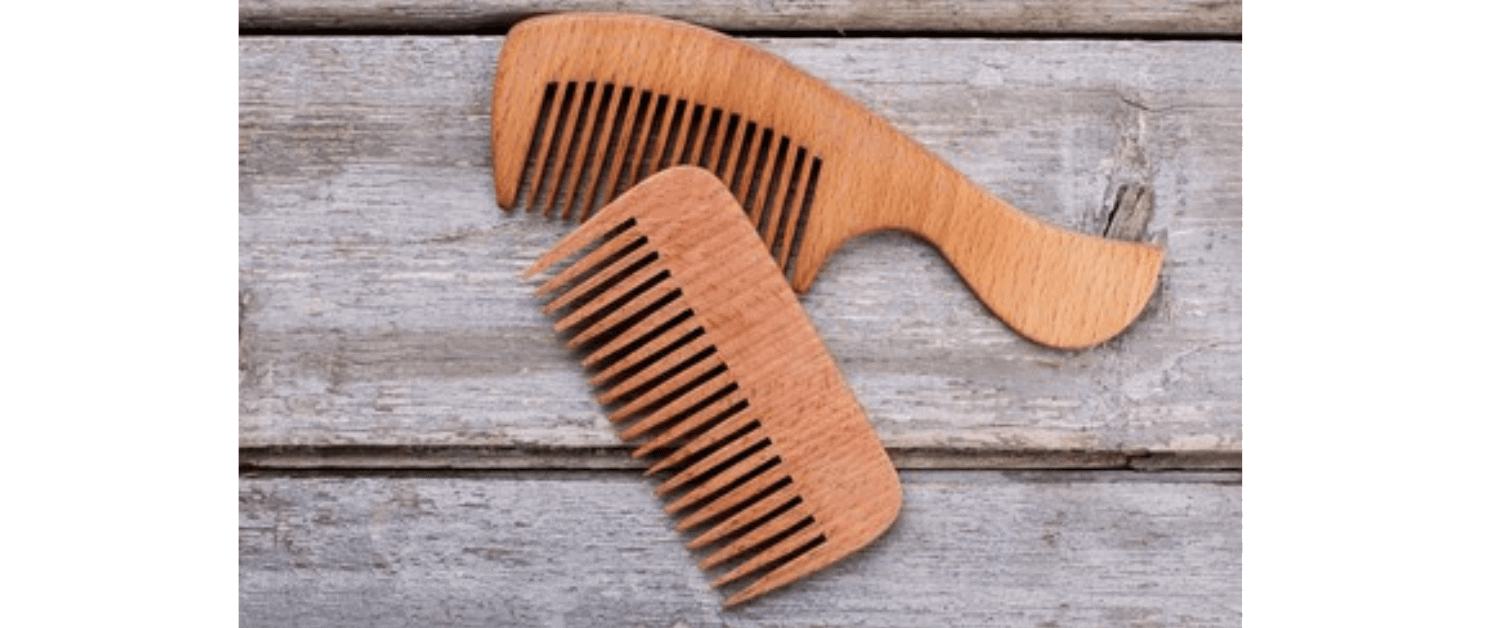
How to Choose the Right Comb for Healthy Hair
Knowing how to choose the right comb for healthy hair might seem like a small detail, but it plays a huge role in your hair’s health. Whether you are battling frizz, breakage, or just trying to maintain smooth, glossy locks, the comb you use matters more than you think. Ayurveda and modern hair science both agree, your comb is not just a styling tool, it is a wellness ally. So, how do you pick the perfect one? Let’s comb through the essentials.
Why the Right Comb Matters for Hair Health ?
Using the wrong comb can silently sabotage your hair goals. Here is why the ideal comb is a game-changer:
-
- Reduces Breakage and Split Ends by Minimizing Friction: Using gentle tools like wooden combs or silk pillowcases helps reduce mechanical stress on hair strands. Unlike plastic combs, these glide smoothly, preventing tugging and snapping. This minimizes split ends and breakage, especially in dry or chemically treated hair. Over time, less friction means stronger, more resilient hair that retains its natural length and thickness.
-
- Distributes Natural Scalp Oils Evenly for Shine and Moisture: Your scalp produces sebum, a natural oil that nourishes and protects hair. When you use a wide-toothed comb or brush regularly, it helps spread these oils from root to tip. This not only adds a healthy, lustrous shine but also keeps the hair shaft moisturized, reducing dryness and dullness. It is nature’s conditioner, and distributing it evenly is key to maintaining soft, glossy locks.
-
- Stimulates Blood Circulation to Hair Follicles, Promoting Growth: Gentle scalp massage or combing activates blood flow in the scalp, which nourishes hair follicles with oxygen and nutrients. This stimulation can encourage faster and healthier hair growth, besides improving follicle strength. It is a simple, daily ritual that supports long-term hair vitality, especially when paired with nourishing oils like bhringraj, coconut, or castor.
-
- Prevents Scalp Irritation and Frizz Caused by Static or Tugging: Plastic combs often generate static electricity, which can lead to frizz and scalp discomfort. In contrast, natural materials like neem wood or horn combs are anti-static and gentler on the scalp. They reduce the risk of inflammation, itching, and hair damage caused by harsh detangling. This is especially helpful in dry climates or during winter months when static is more common.
-
- Supports Ayurvedic Principles of Energy Flow and Scalp Detox: In Ayurveda, the scalp is considered a vital energy centre connected to overall well-being. Regular combing with natural tools is believed to balance doshas (especially Vata and Pitta), enhance prana (life force), and aid in detoxification. It is not just about grooming; it is a ritual. Using a neem or wooden comb aligns with energy channels (marma points), enhancing vitality and calming the mind. It is a mindful practice that harmonizes body and mind, promoting calmness, clarity, and inner balance.
Criteria for Choosing the Right Comb
Choosing the right comb isn’t just about style; it is about protecting your hair’s health and enhancing your daily routine. The material, tooth spacing, and design all play a role in how gently the comb interacts with your scalp and strands. A well-chosen comb can reduce breakage, distribute natural oils, and even support hair growth. Whether you are detangling wet hair, massaging your scalp, or styling, the right tool makes all the difference. Let us explore the essential factors to consider before making your pick.
Hair Type & Texture
-
- Straight or fine hair: Paddle brush or fine-tooth comb
- Wavy hair: Wide-tooth comb or detangling brush
- Curly or coily hair: Wide-tooth comb with rounded tips or finger combing
- Thick hair: Strong, wide-tooth comb for detangling
Tooth Spacing & Shape
-
- Wide teeth: Best for detangling wet hair
- Fine teeth: Ideal for styling and smoothing
- Rounded tips: Gentle on the scalp and reduce scratching
Material Matters
-
- Best choices: Neem wood, boxwood, horn, or carbon fiber
- Avoid: Metal combs (cause static and breakage), low-grade plastic (sharp seams)
Ergonomic Design
-
- Look for a comfortable grip, lightweight build, and durable teeth to avoid hand fatigue and snapping.
Ayurvedic Wisdom: Why Comb Choice Is Sacred
In Ayurvedic tradition, hair care is more than cosmetic; it is a daily ritual that nurtures physical health, emotional balance, and energetic harmony. Combing the hair is seen as a way to stimulate vital energy points, detoxify the scalp, and align the body’s internal rhythms. Here is how specific comb types and techniques contribute to this holistic approach:
-
- Neem Wood Combs: Nature’s Healing Touch: Neem is revered in Ayurveda for its powerful medicinal properties. Combs made from neem wood are naturally antibacterial, antifungal, and anti-inflammatory, making them ideal for maintaining scalp hygiene. Regular use can help prevent dandruff, itching, and minor infections without the need for chemical treatments. The gentle texture of neem wood also reduces static and friction, making it perfect for sensitive scalps and fragile hair.
- Horn Combs: Cooling and Balancing for Pitta Dosha: Horn combs, traditionally crafted from ethically sourced animal horn, are believed to possess cooling properties that soothe the scalp and calm excess heat, making them especially beneficial for individuals with a dominant Pitta dosha. In Ayurvedic terms, Pitta governs metabolism and heat, and when imbalanced, it can lead to inflammation, hair thinning, or scalp irritation. Using a horn comb is thought to restore equilibrium, reduce stress, and promote a sense of calm.
- Scalp Massage While Combing: Activating Marma Points: Ayurveda identifies marma points, vital energy centers, across the body, including the scalp. Gentle combing, especially with natural materials, stimulates these points, enhancing blood circulation and lymphatic flow. This not only nourishes hair follicles but also helps release tension, reduce mental fatigue, and improve overall well-being. It is a simple yet profound way to integrate mindfulness into your daily routine.
Ayurvedic practitioners recommend combing with intention, using slow strokes that start from the ends and always follow the natural direction of hair growth.
Which Combs should you avoid?
Avoid combs made from plastic, metal, or low-grade synthetic materials as they often cause static, scalp irritation, and hair breakage. These combs lack the smooth finish and natural benefits needed for gentle grooming. Poor-quality materials can tug at strands, damage cuticles, and disrupt your hair’s natural oil balance. Choosing the right comb ensures a healthier scalp, shinier hair, and a more mindful hair care routine. After all, the quality of your comb directly impacts the quality of your hair. Combs that you should avoid include:
-
- Plastic Combs
-
- Causes static buildup, leading to frizz and flyaways
- Often have sharp, uneven edges that can scratch the scalp and damage hair cuticles
- Non-biodegradable and environmentally harmful
- May contain toxic dyes or chemicals that irritate sensitive skin
-
- Metal Combs
-
- Too harsh on the scalp, especially during detangling
- Can pull or snap hair strands, increasing breakage
- Not suitable for sensitive or inflamed scalps
- May heat up quickly, causing discomfort during styling
-
- Low-Quality Synthetic Combs
-
- Often made with cheap resins or mixed plastics that degrade over time
- It can warp or crack, creating jagged edges that harm hair
- Lacks the natural benefits found in wood, horn, or bamboo combs
- May emit unpleasant odors or leach chemicals when exposed to heat
Tips to Maintain Your Comb for Healthy Hair
A clean comb is a healthy comb. Here is how to care for it:
-
- Clean weekly: Soak in warm water with mild shampoo, scrub gently with a toothbrush
- Avoid soaking wooden combs: Wipe with a damp cloth and dry immediately
- Store properly: Keep in a dry, clean place to prevent mold or bacteria
- Don’t share combs: Prevents lice, dandruff, and scalp infections
- Replace damaged combs: Cracked or warped teeth can snag and break hair
For more detailed information on how to maintain your hair brush, visit How to clean a Hairbrush at Home
Bonus Tips for Healthier Hair Combing
-
- Comb from ends to roots to avoid tugging
- Use leave-in conditioner before detangling
- Don’t comb wet hair aggressively; use a wide-tooth comb only
- Massage scalp while combing to boost circulation
- Use natural oils like coconut or almond before combing for extra nourishment
Conclusion:
Choosing the right comb goes beyond aesthetics; it is a vital step in nurturing your hair from root to tip. Whether you are guided by Ayurvedic hair care principles or modern hair science, the tool you use can impact scalp health, shine, and growth. From neem wood to horn combs, each material offers unique benefits for your daily hair routine. So, the next time you reach for a comb, let it be a mindful choice, one that supports both beauty and well-being.



